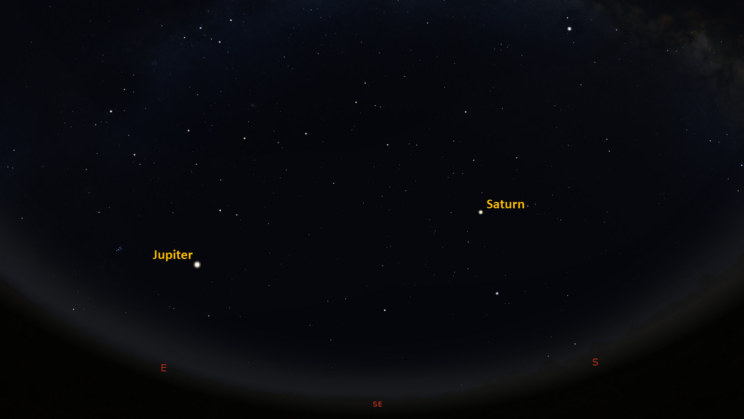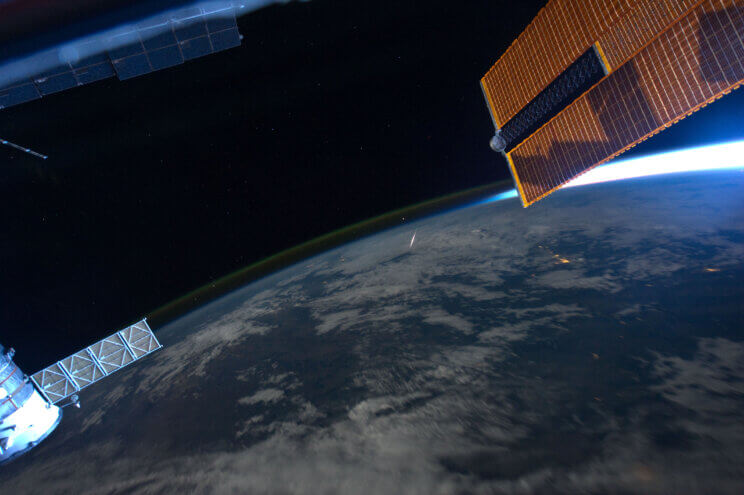This is the Saint Louis Science Center’s NIGHT SKY UPDATE for the week of Saturday, August 12, 2023.
Information updated weekly or as needed.
Times given as local St. Louis time which is Central Daylight Time (CDT). For definitions of terminology used in the night sky update, click the highlighted text. If relying on times posted in Universal Time (UT), St. louis is -5 hours when CDT.
Public Telescope Viewings
As part of the Saint Louis Science Center’s First Fridays, weather permitting, the St. Louis Astronomical Society and the Science Center will set up a number of telescopes outdoors and be on-hand to answer your questions. Telescope viewing begins once it is dark. Regardless of the weather on September 1 , join us indoors in our planetarium theater for “The Sky Tonight”. Showtime is at 7 p.m. There is no First Friday event in July.
Observing Highlight of the Week
Perseid meteor imaged by expedition 28 astronaut Ron Garan in 2011. Image credit: NASA
This week’s highlight is the annual Perseid meteor shower. Every year from mid-July to the start of September, Earth encounters debris from a comet called 109P/ Swift-Tuttle. This annual encounter causes the Perseid meteor shower which tends to be one of the best meteor showers each year. This year in particular is good due to the phase of the Moon being just a few days from new moon. Unfortunately for us in the St. Louis area, the weather outlook is not looking good.
Comet 109P/Swift-Tuttle is a short period comet that orbits the Sun every 133 years. Comets are made up of rock, dust and ice that are frozen leftovers from the formation of the solar system. Most of the time they are far enough from the Sun that their icy material remains frozen. As they get closer to the Sun, the ice in comets begins to sublime causing the comet to spew gases as it heats up. Along with the gas, dust and some rocky materials are ejected as the comet sublimes causing the debris streams that Earth will encounter if the comet’s path is near enough to Earth’s orbit.
The meteor shower caused by comet 109P/Swift-Tuttle is called the Perseid meteor shower. It occurs every year from roughly July 14 to September 1 with a peak date usually around August 12 and 13. During peak activity, the zenith hourly rate of the Perseids is 100 meteors per hour. Keep in mind this is if viewing from a dark location. From an urban setting that number is closer to 10 to 20 per hour. The Perseids are a shower that is worth viewing no matter where you find yourself, but it is advised to drive somewhere dark if you can.
This is a good year for the Perseids owing to the current moon phase. On August 12, the Moon will exhibit a waning crescent phase with roughly 9% disk illumination once it rises after midnight. Years when the Moon is closer to full moon will not be as good simply due to how bright the Moon is when near full.
A factor that is more location specific is the timing of peak activity. The moment the Earth is nearest the orbit of comet 109P/Swift-Tuttle is when we would encounter the most debris from the comet. Every year the time of this changes by roughly 6 hours. This is because our calendar measures a cycle called a tropical year that is 365.242189 days long. Being that .242189 days is roughly a quarter of a day; the radiant time shifts 6 hours forward each year. In St. Louis, the 2023 Perseid peak is expected to occur around 3:00 a.m. CDT.
To recap, what makes a good year for meteor showers is based on several factors. The amount of light pollution you experience will be one of the most important factors. If you live in St. Louis, it is best to go somewhere about 2 hours away. Moon phase also has an impact. The closer to new moon the better. Timing of peak activity helps determine where on Earth will best see the display. And lastly, the weather. Weather is always the most difficult factor to predict. The models meteorologists use to predict weather conditions are always fluctuating. We all know someone who complains that the weather forecast is never right. The reality of a forecast is it is just a prediction based on current conditions and future possibilities. It is impossible to predict weather 100% accurately. A good example is when I started writing this, the forecast showed that we would have overcast skies when the meteor shower is visible. In a matter of hours, conditions changed enough that forecasts are now suggesting mostly clear skies from 7 pm to 5 am. Maybe this will hold true or maybe it will change again. The only way to know for sure is to look outside when the time is right.
Your best chance to see meteors tonight will come after midnight when the Perseid radiant is overhead. A meteor shower radiant is the point in the sky meteors appear to emanate from. For the Perseids, the radiant is located between the head of Perseus and the W-shape of Cassiopeia. Keep in mind you do not need to look right at this spot, as meteors will emanate from it in all directions. The Perseid radiant can be found rising in the northeast as soon as it is dark. Most of us likely have trees or buildings so expect Perseus to be visible by 9 or 10 pm. At this time, the radiant is fairly low so meteors will be limited. Ideal viewing conditions occur between 2 and 5 am as the Perseid radiant climbs higher in the sky.
If weather ends up ruining this years Perseid display, it will happen again next year around the same time. Unfortunately, the Perseid peak will not be as favorable as it is this year, but regardless, the Perseids are always a meteor shower worth watching. You can find out more about meteors at the American Meteor Society or the International Meteor Organization.
The Sun and Moon

The Moon as seen from the International Space Station, on July 31, 2011.
Credit: NASA
Sun
Sunrise is at 6:12 a.m. on Saturday, August 12 and sunset is at 7:59 p.m. providing us with just under 14 hours of daylight. Even after sunset, light from the Sun will dimly illuminate our sky for about 1 hour and 40 minutes. This period is called twilight, which ends around 9:39 p.m. this week. For those with a sundial, local noon occurs around 1:05 p.m. this week.
| Day | Sunrise | Sunset | ||||||||||
|---|---|---|---|---|---|---|---|---|---|---|---|---|
| 12-Aug | 6:12 a.m. | 7:59 p.m. | ||||||||||
| 13-Aug | 6:13 a.m. | 7:58 p.m. | ||||||||||
| 14-Aug | 6:14 a.m. | 7:56 p.m. | ||||||||||
| 15-Aug | 6:15 a.m. | 7:55 p.m. | ||||||||||
| 16-Aug | 6:16 a.m. | 7:54 p.m. | ||||||||||
| 17-Aug | 6:16 a.m. | 7:53 p.m. | ||||||||||
| 18-Aug | 6:17 a.m. | 7:51 p.m. | ||||||||||
| 19-Aug | 6:18 a.m. | 7:50 p.m. | ||||||||||
| 20-Aug | 6:19 a.m. | 7:48 p.m. |
Moon
Moonrise for Saturday, August 12 was at 2:18 a.m. and moonset occurs at 6:11 p.m. On Saturday, August 12, the Moon will exhibit a waning crescent phase with 9% disk illumination. New moon occurs on August 18, 2023, at 4:38 a.m.
International Space Station (ISS) Observing

There are several visible passes of ISS from St. Louis for the week of July 29. They occur during evening hours. The best passes for this week are listed below. Use the table below for information about these passes.
Catch ISS from St. Louis starting Saturday, August 12
| Date | Starts | Max. altitude | Ends | |||||||
|---|---|---|---|---|---|---|---|---|---|---|
| Time | Alt. | Az. | Time | Alt. | Az. | Time | Alt. | Az. | ||
| 19 Aug | -1.1 | 5:32:05 | 10 | SSE | 5:34:10 | 16 | SE | 5:36:15 | 10 | E |
| 21 Aug | -3 | 5:31:48 | 10 | SSW | 5:35:02 | 48 | SE | 5:38:18 | 10 | ENE |
Magnitude (Mag): The Measure of brightness for a celestial object. The lower the value is, the brighter the object will be.
Altitude (Alt): The angle of a celestial object measured upwards from the observer’s horizon.
Azimuth (Az): The direction of a celestial object, measured clockwise from an observer’s location with north being 0°, east being 90°, south being 180° and west being 270°.
For information about ISS flyovers and other visible satellites, visit www.heavens-above.com
Detailed information regarding all unmanned exploration of our universe, missions past, present, and planned, can be found at Jet Propulsion Laboratories:
The Visible Planets

Looking southeast at 1:30 a.m. on August 12, 2023. Credit: Stellarium, EG
This week, three naked eye planets will be visible. Mars is still visible in the west about 30 minutes after sunset. It will be low so twilight will make spotting Mars challenging. Saturn and Jupiter will be easy to find but you will have to go out in the late evening and morning hours. Saturn will be in the southeast around 11:00 p.m., while Jupiter will be east in the early morning.
Mars
Mars now rises before sunset, becoming visible once it is dark. Look for it in the west about 30 minutes after sunset. Mars sets at 9:17 p.m.
Jupiter
Jupiter rises at 11:36 p.m. About one hour after Jupiter rises, it should be easy to spot. Jupiter will rise about 20 minutes earlier each week.
Saturn
Saturn rises at 8:42 p.m. Start looking for Saturn about 30 minutes after it rises. If you have lots of trees or buildings, you may have to wait an hour or so after it rises before it will be visible. Saturn reaches opposition on August 27, 2023.
James S. McDonnell Planetarium
Night Sky Update: August 12-20, 2023







